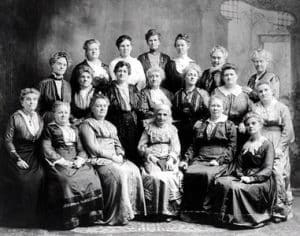by Kelly Ann
I have been asked to highlight the new book Daughters in my Kingdom for a Relief Society Lesson. Having read the book, a couple related conference talks by President Beck, Starfoxy’s review here at the Exponent blog , Bridget Jack Jeffries review at Clobberblog, Sarah Familia’s review at Times and Seasons, Ingrid Lola’s review on Goodreads, Ardis Prashall’s critique of the pictures in the book, and recent comments on FMH, I feel like I have a good sense of the book as well as points of controversy.
However, given that I have been given more time to teach the lesson, I keep rethinking what I want to present. It is a little bit of an intimidating task. Reading or writing a review (which I am also working on) is quite different than preparing a lesson plan. You could also say that my opinion is somewhat jaded … And while my ward accepts me for the liberal odd woman that I am, I want to give a fair overview. Although after reading Ardis’ review I may show some of the pictures ;-). I will probably reinforce the idea that the book was written for the whole church to avoid some of the major points I see.
So I just want to ask everyone here, if you were in my shoes and asked to highlight the book in a lesson, how would you do it?
My thought is to share excerpts of the book that I like from different time periods to give people a sense of the book. While I think the book is far from perfect, I would like to encourage people to read it. My greatest fear is that it goes ignored by the majority and am thus grateful that my Relief Society Presidency is highlighting it. I think if everyone learns the basic information presented in it, it opens the further opportunity for discourse and the opportunity to discuss the problematic points. I also want everyone to leave Relief Society to inspire the men in their life to read it as I wish the book and conference talks were given to men as well as women. I really like that the book has so many quotes from women and can be used as a source to quote from in General Conference (as did Barbara Thompson did in the main session).
So what quotes would you share? But more importantly as I am mostly struggling with how to turn the lesson into a discussion, I would welcome any input on how you would do that. What questions would you present in a general overview?
Anyhow, I really appreciate any input. I realize that this is an odd request/ post. I will ultimately post the outline that I have prepared (which probably isn’t so bad) but just want to see if I can enrich it.
Thanks.





17 Responses
Good luck. I’m afraid I would decline the invitation. 🙁
That’s fair enough. I think I have to be careful not to overpitch it.
I am trying to like the book (not too successfully, so far) because I like the idea of the book–I think it is important to remember the history of women. Maybe you could talk about why it is important to remember women of the church, not just men, and even suggest some other sources to learn such history to “complement” reading DIMK?
Yes, that is a great idea. Are there are any sources you would suggest? The ones I think of are Women of Covenant and Mormon Enigma. Our RS book group actually read The Gathering of Zion: The Story of the Mormon Trail by Wallace Stegner last year.
I’d also recommend Sisters in Spirit: Mormon Women in Historical and Cultural Perspective, and, to a lesser extent, Mormon Sisters: Women in Early Utah.
I am a stare-the-devil-in-the-face kind of gal, (or so I have been accused), so I would open with the controversy. Doing so would get attention and I think would encourage people more to read it. I love Starfoxy’s critique, so I would address (briefly) the issues with those who have so far made critical or negative comments. I would also highlight the mention of it in overall General Conference, including the one male speaker (I forget who) who mentioned it. I would celebrate the quoting of women and teach them that it is an excellent speaker’s reference book– for both men and women. After this, I would ask if there is anything that the women hope will be there– what stories have struck them about the history of Mormon women that they hope are encapsulated in the book? I might also feel inclined to encourage the women to write their own stories; the church had ample stories of prophets, but is in need of documentation of every day LDS women.
Can’t wait for your post on the lesson 🙂
Thanks Spunky. I also really like the idea of encouraging people to write their own histories.
Although it scares me to think that someday people might be quoting the blogs….
I am writing about my reactions to it as I read it on my blog.
So far, I am pleasantly surprised by what I’m learning/feeling/thinking.
That is a cool thorough approach. Ill take a look at it.
I think this book is helpful in wards that are strict about only using Church-generated sources for teaching lessons. There are some quotes here that I can use in my lesson preparation. I love that there are lots of pictures because again, I can get use those pictures of women in my lesson preparation for other classes. I do think that Ardis’ assessment is spot-on. I particularly love what she says when she talks about the excessive use of pictures: [They] bring to mind the contrast between “Holy books for men” and “Lovely picture books for women.” Sigh…
I think this book is a baby step, and as someone who looks to bring out women’s voices in every lesson I teach in Church, I’m happy to have this resource.
I’m disappointed that it’s not a first Sunday or fifth Sunday manual, or how great would it be to have a “History and Work Of Relief Society” special Sunday School class (sign me up for that over Marriage and Family Relations 🙂 )?
I’d love to see someone write up an Enrichment (what are we calling it now?) mini-class that looks at a chapter a week and supplements readings from other sources like Women of Covenant or some Chieko Okazaki or Sheri Dew books (like April, you and Petra already mentioned).
EmilyCC, I agree it would be great for somebody to go through the book in that level of detail … Although I don’t think I am ambitious enough for the task.
Any new book or program is going to have pro’s and con’s. I think it is a fantastic step forward to have so many women’s stories available. Certainly not meant to be all-inclusive, but to get the ball rolling. Not a bad beginning – especially if we see it as a beginning.
About the pictures – perhaps a good point, that a book of lovely pictures is associated with women, but I also remember Sis. Beck saying she was concerned about reaching all women across the world, many of whom are almost illiterate. A book without those pictures may have been intimidating for some of these women. And as mentioned above, those pictures are ready-to-hand in other lesson situations (especially YW, right? 🙂 ).
Good luck with the lesson.
Thanks for your thoughts Karen. I agree that there is value to the pictures. However, I don’t think they need to dominate the book the way they do. I’d like to believe there is a medium.
Will there be any posting for lesson 44?
Joan, Please see the following link. https://exponentii.org/2011/10/15/9212/ We apologize for the delay in getting it up.
I taught a similar lesson last week. I shared the quote on p. 76 about it being better to walk with God in the dark than without him in the light., the quote on p. 4 about Christ encouraging women to participate in a spiritual way not just by serving, and a quote on p. 5 about cultivting christlike qualities. I asked sisters to share how these idea have been shown in their lives. I wish I had stopped here and let them write about their lives. But I also read some of D&C 25 and asked what they had learned about being good wives. Interestingly I got a bunch of one word answers. Finally I read snippets of the notes of the early RS meetings on p. 22 and asked how we could make relief society more practical like this. Again wish I had done that as a seperate lesson for the whole lesson. I would love to hear what you do because I will steal from it for another lesson.